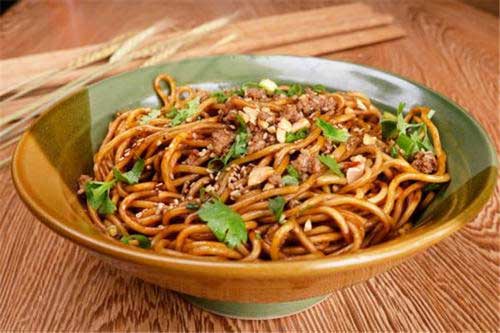Hot dry noodles is one of the most famous snacks in Wuhan. There are many methods. It uses alkaline water, and uses cooking oil, sesame paste, salad oil, sesame oil, chives, garlic seeds, diced radish, capers, brine juice, raw Supplementary materials are drawn. The hot-dried noodles are yellow and oily in color and delicious. Because of their high calories, they can also be used as a staple food for a nutritious breakfast to supplement the energy needed by the body.
Historical Origins
 Wuhan has a high temperature in summer, and it spans a long period of time. For a long time, people have added edible alkali to the noodles to prevent deterioration. This is the predecessor of hot-dry noodles-cut noodles. In the Qing Dynasty “Hankou Zhuzhi Ci”, there is a record: “Three days too early is unusual, a wolf meal can be forgotten. Sliced noodles with dried bean curd noodles, fish meal balls and chicken soup.”
Wuhan has a high temperature in summer, and it spans a long period of time. For a long time, people have added edible alkali to the noodles to prevent deterioration. This is the predecessor of hot-dry noodles-cut noodles. In the Qing Dynasty “Hankou Zhuzhi Ci”, there is a record: “Three days too early is unusual, a wolf meal can be forgotten. Sliced noodles with dried bean curd noodles, fish meal balls and chicken soup.”
At the beginning of the 20th century, the food vendor Li Bao continued the previous method of cutting noodles. The noodles were cooked, drained, and mixed with sesame oil to make hot and dry noodles with a unique flavor. Later, Cai Mingwei inherited Li Bao’s skills, and repeatedly improved and formed a set of specific technical processes, creating “Cai Lin Ji Hot Dry Noodles”, which is famous for its “fresh and strong, yellow and oily, fragrant and delicious”.
Hot dry noodles originated from Cai Mingwei who sold noodle soup on Changdi Street in Hankou in the early 1930s. Cai Mingwei is a native of Huangpi Cai Zha. His noodle soup is very popular. Customers often wait in line for a long time to buy. Many customers can’t wait to leave. Cai Mingwei is very smart in business. In order to speed up the shipment volume, through trial and error, he finally figured out a set of “brushing the noodles” process-first cook the noodles to be mature, then quickly cool down and evenly grease the noodles. Soon. Once Cai Mingwei saw a sesame oil workshop on Changdi Street. After seeing them extract sesame oil from sesame seeds, the sesame paste was left aside and the aroma was tangy. He had an idea; why not add sesame paste to the noodles for a try, so Cai Mingwei I bought some sesame paste from the sesame oil workshop owner and went home. After many trial and error, he felt satisfied, and everyone around him said it was delicious. Only then did he confidently launch his new products on the streets. Hot dry noodles-the favorite snack of Wuhan people was born. At this time, Cai Mingwei named the noodles “sesame sauce noodles” and it was not officially called “regan noodles” until the industrial and commercial registration in 1950.




